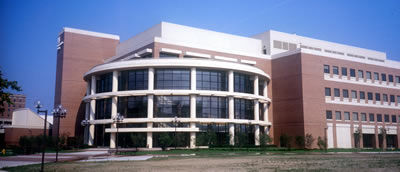Overview
The University of Michigan-Flint’s William S. White Building, (formerly known as the Professional Studies and Classroom Building) is a new four-story, 177,400 sq. ft. facility providing both departmental offices and state-of-the-art classroom facilities for several health care related curricula, the School of Management, the local Public Broadcasting System affiliate WFUM-TV and portions of the Art Department and the School of Education.
Health care curricula included within the building’s programmed space include offices for the Dean of Health Professions and Studies, the Departments of Nursing, Physical Therapy, and Health Care as well as an Urban Services Clinic emphasizing physical therapy, wellness and prevention.
Another feature of the facility is the inclusion of an Early Childhood Development Center offering Education Department students the opportunity for “real life” situational studies and a daycare center for faculty, staff and students at the University.
A major thrust of the building’s design centered on the University’s desire to reach out to the region by creating a facility that provides a visible, accessible, “user-friendly” face to the community. An Instructional Technology Center provides not only the capability to provide state-of-the-art alternative learning materials and courses, but also provides seminar and meeting spaces which permit a desirable connection between “town” and “gown,” a particular focus of the School of Management. The facility will feature multi-media classrooms and distance learning capabilities for both origination and reception of programming.
The general design concept uses a contemporary collegiate approach to echo the existing campus architecture. Gentle curves are incorporated to visually relate to the library and other campus buildings. Great effort was taken to visually reduce the overall image and mass using step-back corners, setbacks at the fourth level, and curves to soften the edges.
Careful attention is given to pedestrian access both from the south campus and newly created north campus entrances and parking. The design is respectful of a future 300-vehicle parking structure proposed to the west. The design stands on its own now, but considers the visual impact of this parking structure as well as its affect on entrances, pedestrian circulation, building spacing, and landscape areas.

